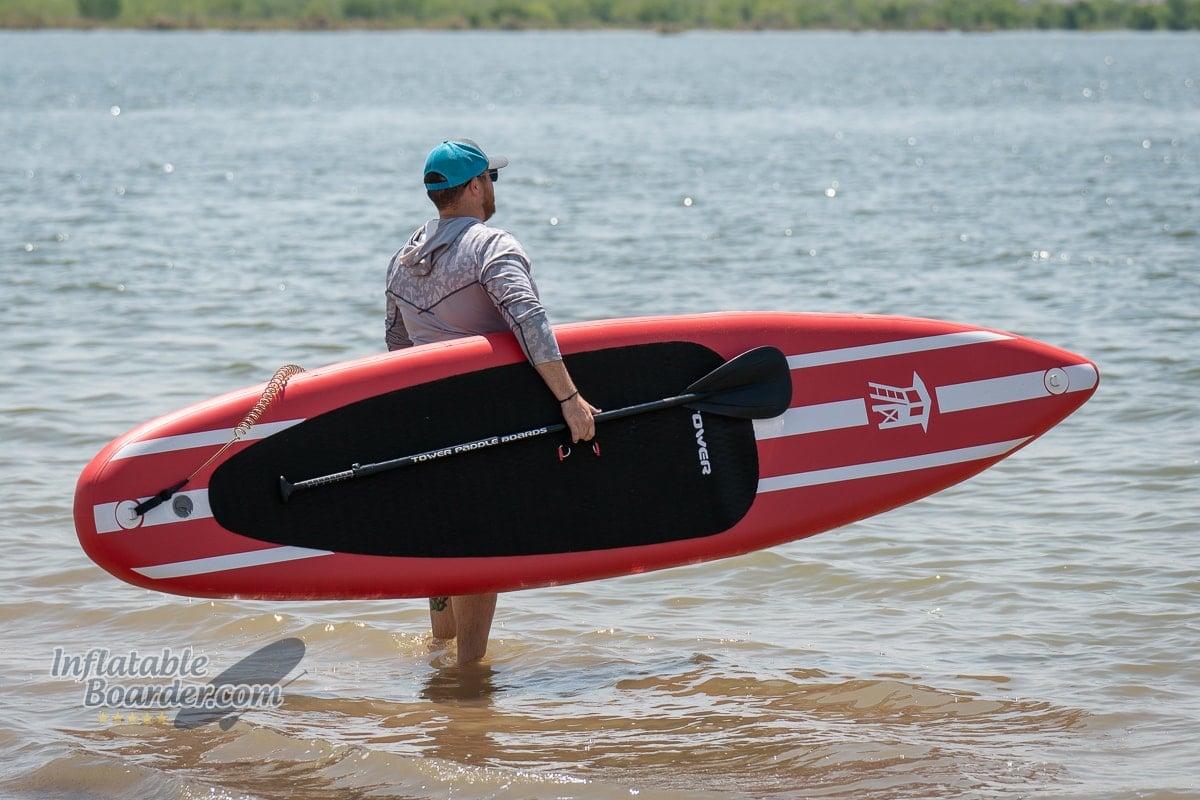
The Tower iRace is a minimalist touring-style iSUP best used for shorter fitness paddling sessions
Tower iRace iSUP: Overview
The Tower iRace touring-style iSUP is a longer, narrower board for paddling more efficiently over longer distances. While the iRace is noticeably faster on the water than Tower’s other Premium Series iSUPs, it does lag behind in speed and efficiency compared to many other dedicated touring boards. The iRace also lacks the ability to carry any cargo needed for longer trips on the water. Without the ability to bring along on-water essentials, the Tower iRace is best used as a short-distance fitness paddle board.
— iRocker All Around 10’ Summary Ratings and Review —
Tower iRace iSUP Review 2024
-
Construction & Durability
-
Features and Versatility
-
Stability
-
Speed
-
Maneuverability
-
Tracking
Overall Score
The Tower iRace is a fitness-oriented touring-style iSUP with no cargo capacity
Pros
- Double layer glued construction is durable and offers moderate rigidity
- The elongated shape aids in stability for this narrower iSUP
- Diamond texture deck pad provides good traction
- Balances maneuverability and tracking well
- Hook and Pin fin system is easy to use
- 2 year warranty
Cons
- The lack of any cargo space on the board severely limits its usability for more than a short paddle session
- The lower pressure rating reduces the iRace’s stiffness, impacting its performance
- Included fiberglass paddle does not match well with a faster paddling style
Construction and Durability
The Tower iRace iSUP uses Tower’s double-layer, hand-glued construction method. This does create a durable board, however it increases the chance of cosmetic blemishes and defects.
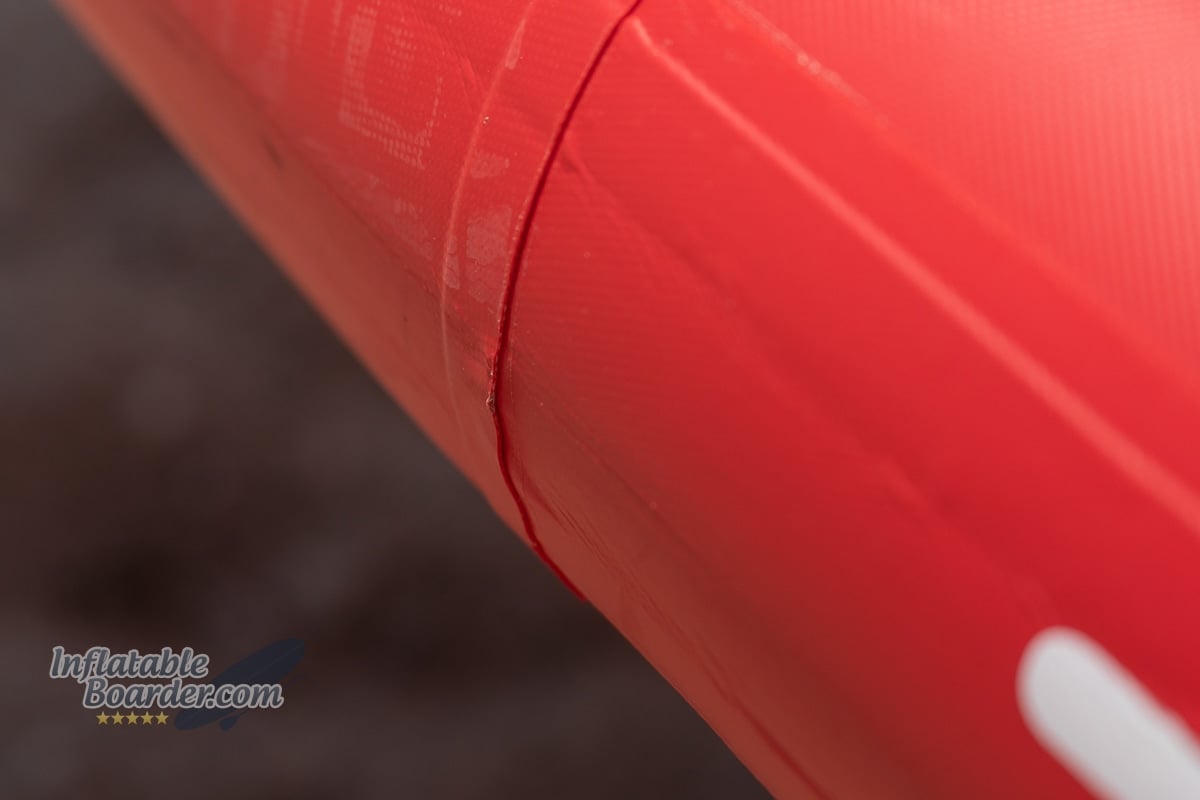
The Tower iRace iSUP I received had numerous cosmetic blemishes and this gluing defect that could potentially cause issues in the future. This type of defect is covered by Tower’s warranty.
The Tower iRace is part of Tower’s Premium Series iSUPs built with a hand-glued double layer PVC construction. The board starts as two sheets of a synthetic knitted fabric connected with thousands of drop stitch yarns. These yarns have a set length that determine the board’s thickness (6” in this case). A liquid PVC coating is then applied to the fabric layers and cured in order to make the fabric stiffer and air tight. Next a layer of reinforced PVC Tarpaulin is hand-glued to the first layer. This provides the bulk of the board’s durability and stiffness.
Once the fabric lamination process is complete, the board’s outline is cut from the fabric and the top and bottom layers are joined together at the rails. A piece of PVC is glued to the top and bottom edges to bring the sides together and complete the airtight chamber of the board. Another layer of PVC is then glued all the way around the side of the board. This outer rail band protects the inner seam and helps further reduce flex.
The hand gluing process has been around for a long while and does produce highly durable inflatable paddle boards. However as with any hand made process there is more room for error, blemishes, and defects. In the case of the copy of the Tower iRace I have there were numerous “bubbling” defects throughout the board that are caused by small pockets of air that were trapped in the glue during that process. These cosmetic issues don’t actually impact the functionality or performance of the board. The outer rail band also suffered a gluing defect that would be a cause for an immediate warranty claim, though. The end of the outer rail band was not glued down properly. It is bunched and the edge is lifted off from the underlying layer (shown above). Because the outer rail band layer is not technically part of the air chamber this defect won’t cause a leak or affect performance, but could lead to the outer band delaminating in part from the rest of the board later down the line.
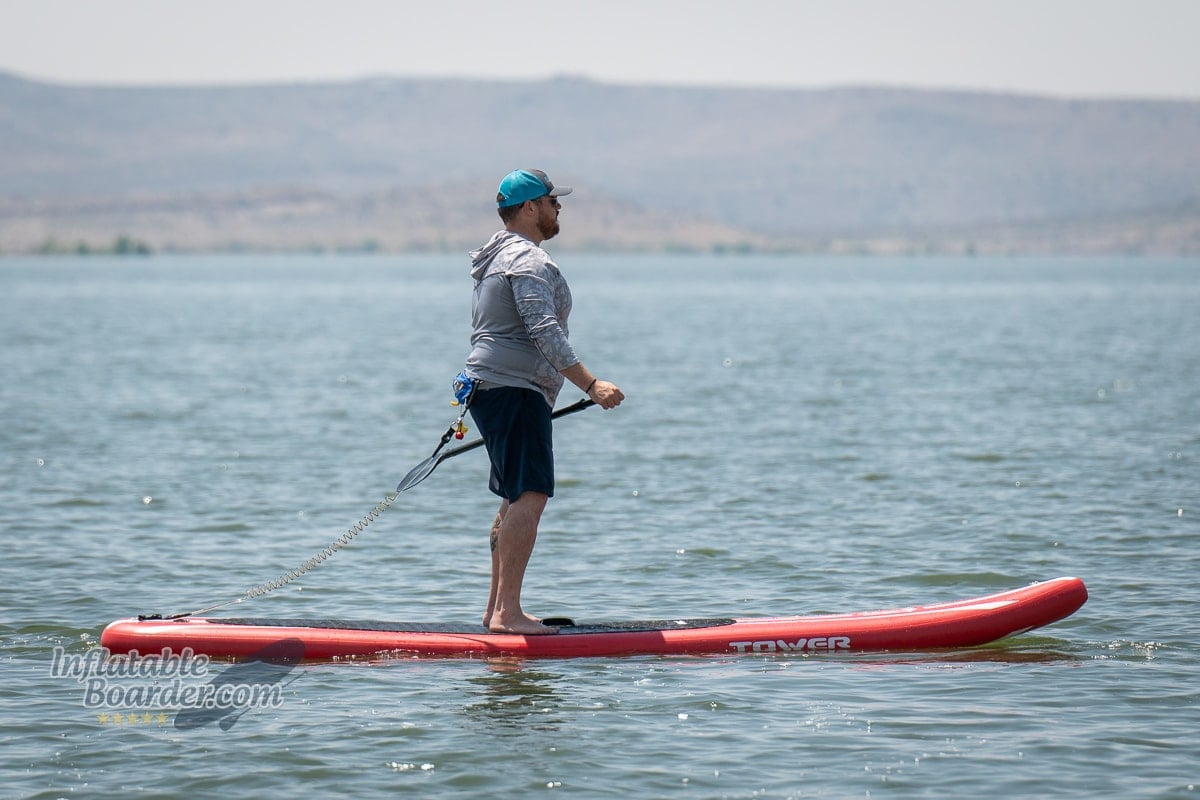
There is a slight flex in the board while standing and during normal paddling
In our static bend test we load fully inflated boards with 170 lbs of weight across a seven foot gap and measure the resulting deflection to see how rigid they are. The Tower iRace bent 2.13” which is significantly more than both our running average (1.57”) and Tower’s other Premium Series iSUPs (1.73”). Narrower iSUPs do tend to exhibit more flex than wider, similarly built boards, so this isn’t too much of a surprise, especially since Tower recommends a maximum inflation pressure of only 12 PSI for “optimal performance.” Most modern iSUPs recommend 12-15 PSI, and many are rated up to 20 PSI for increased rigidity. We typically see improvements up to 0.25” in our bend test between 15-20 PSI. I’m not sure raising the internal pressure from 12 to 15 PSI would be enough to bring the Tower iRace in line with Tower’s other Premium Series boards.
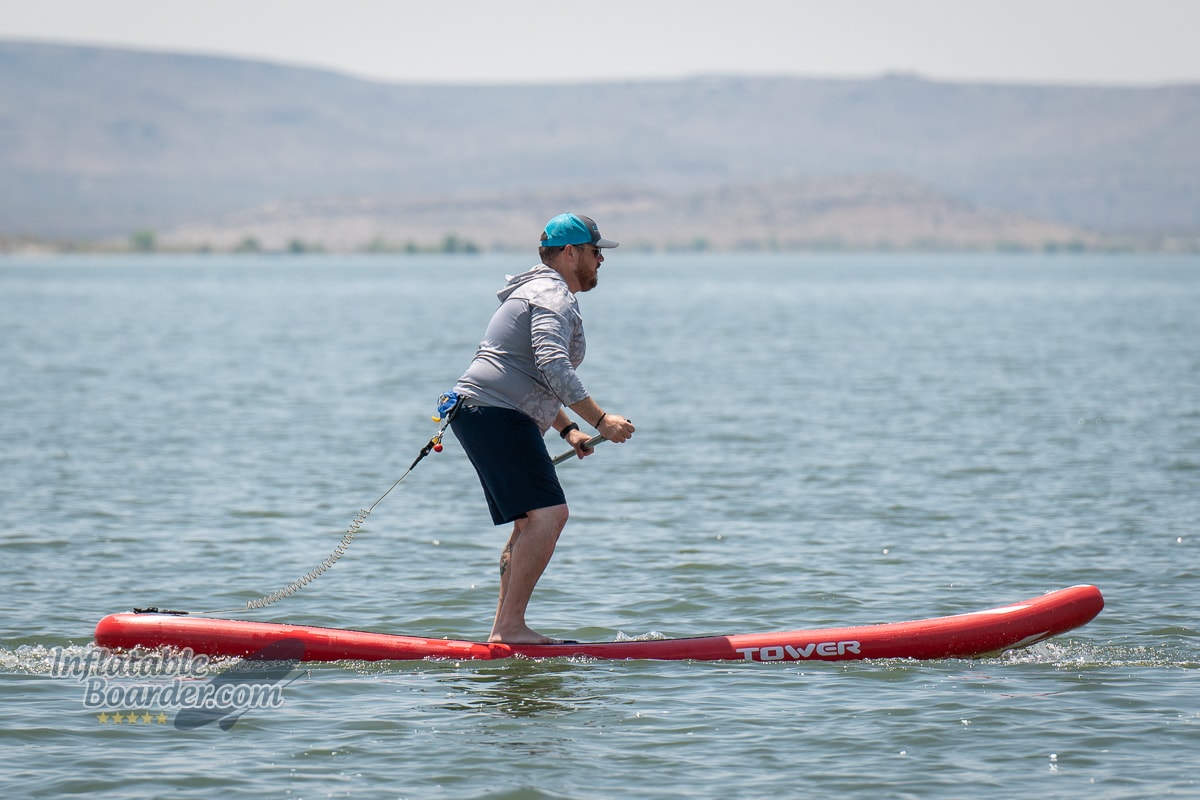
When paddling with more effort or putting more pressure on the board, the iRace does have a high amount of flex.
On the water the Tower iRace did show some flex while standing and paddling at a casual pace. The flex became much more pronounced as pressure increased on the board during faster, harder paddling (especially sprinting). Large steps and jumping on the board also produced high amounts of flex. Where the other Tower Premium Series iSUPs have a tighter feeling rebound, the length of the iRace helps absorb and release that flex in a much softer manner.
I have no doubt that with a higher recommended pressure rating the Tower iRace would do better in both our bend test and improve the board’s performance on the water.
Specifications
| Dimensions | |
| Length | 12’ 6” |
| Width | 30“ |
| Thickness | 6“ |
| Weight | |
| Max Capacity | 400 pounds |
| Board Weight | 27.5 pounds |
| Kit Weight |
34 pounds |
| Buying Info | |
| List Price | $ |
| Warranty | 3 years |
| Returns period | 30 days |
Features, Accessories and Versatility
The Tower iRace shares the same size and relative shape with many touring iSUPs, but is essentially devoid of any features on the board itself greatly limiting its overall versatility.
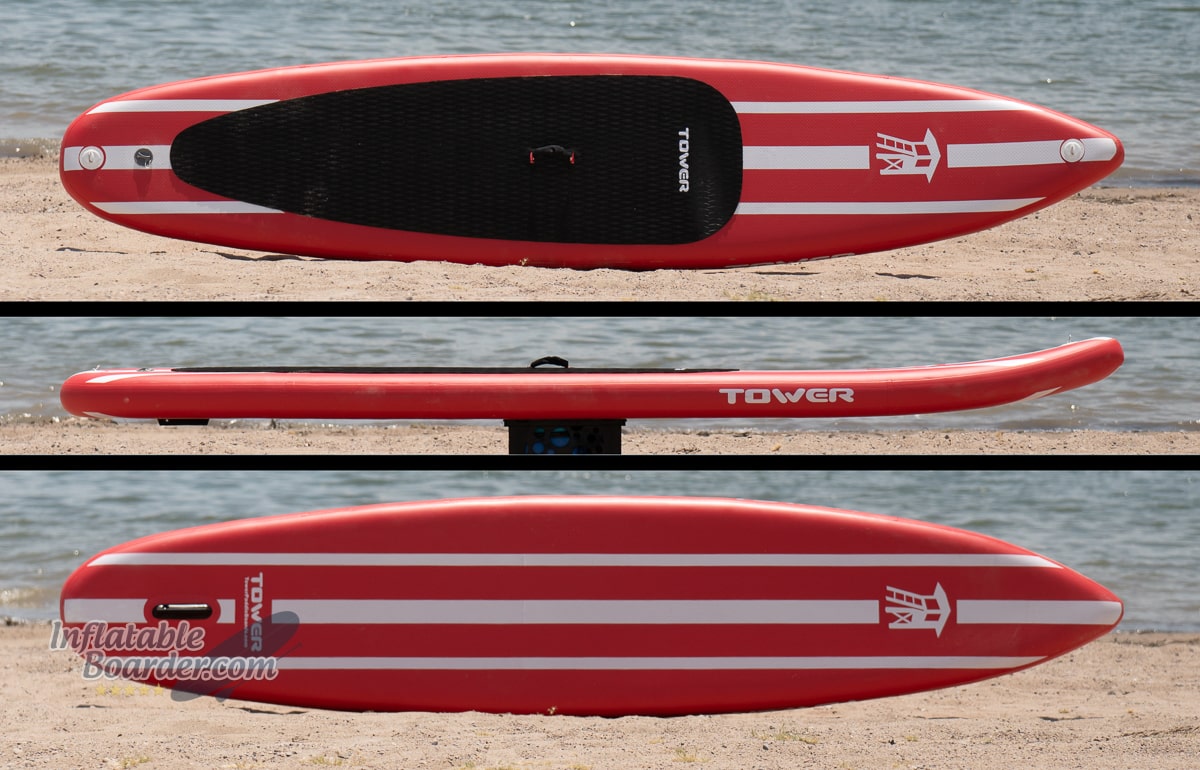
The Tower iRace is 12’ 6” long, 30” wide, and 6” thick. It has a maximum weight capacity of 400 lbs and maximum inflation pressure of 12 PSI.
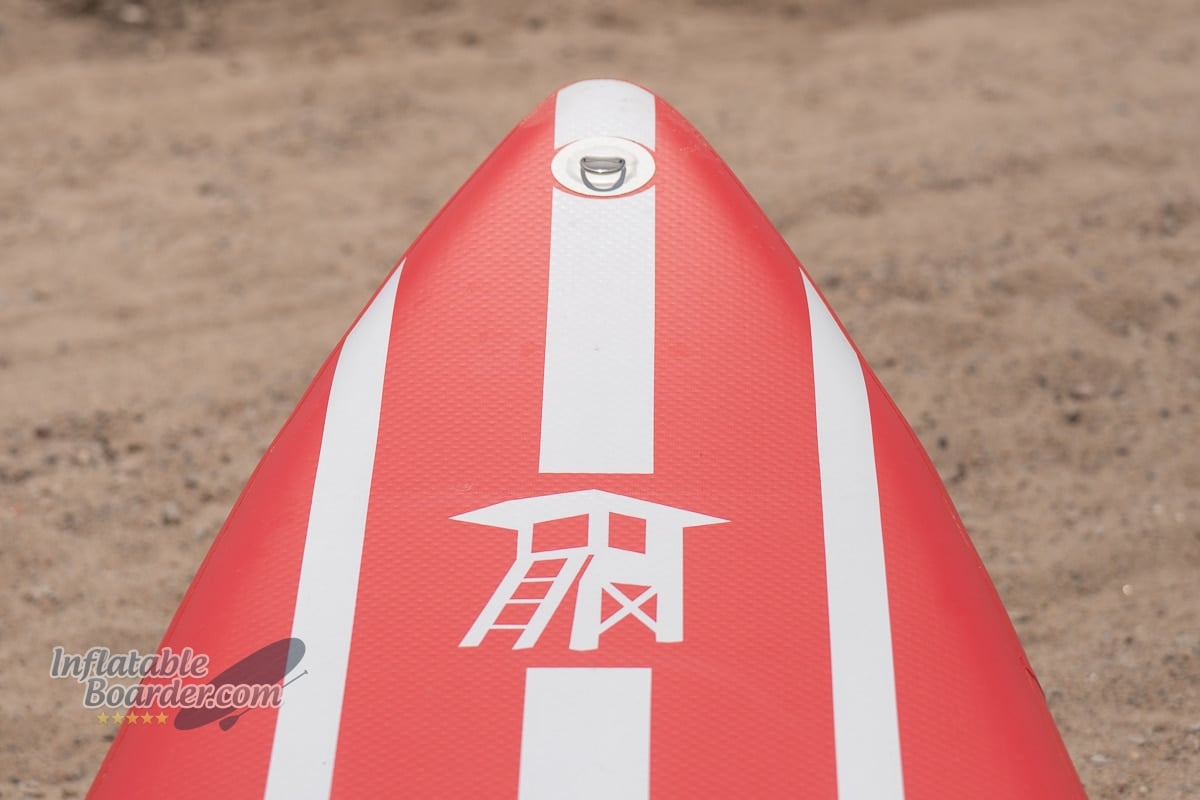
The nose of the Tower iRace comes to a gradual point with a moderate amount of rocker for paddling through choppy conditions. The nose D-ring is the only tie down or attachment point on the front of this board.
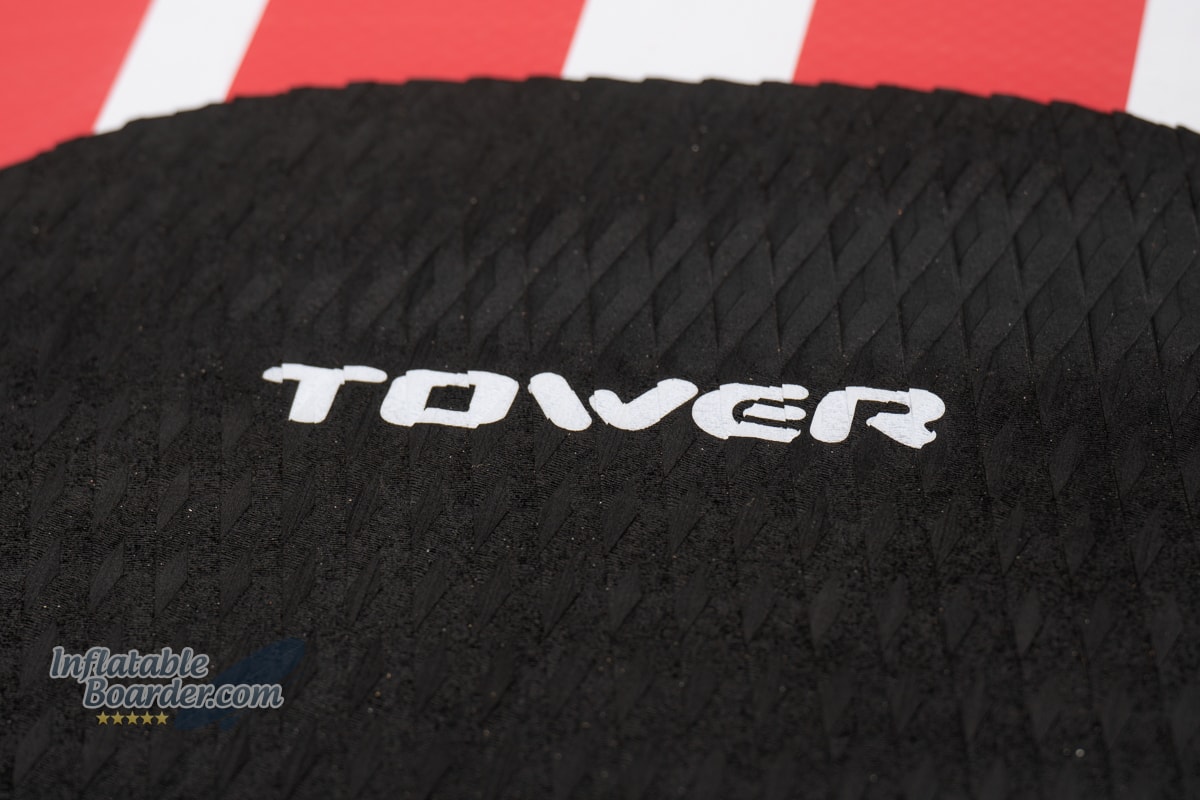
The diamond pattern deck pad provides a good amount of grip with bare feet or shoes. The pad narrows greatly at the tail and ends right over the fin box. It would greatly benefit from a kick pad for better control while pivot turning.
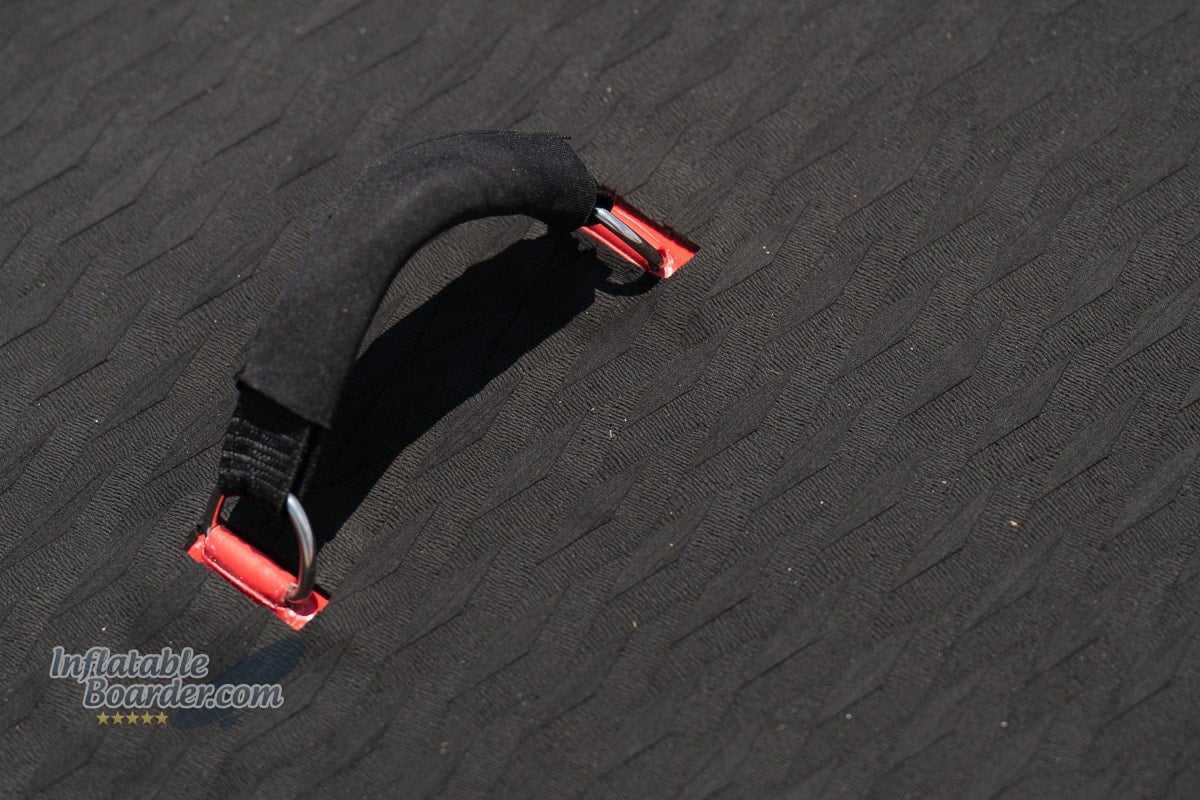
The center handle is the only carrying option on the Tower iRace. The handle is lightly padded, removable, and strung between two steel D-rings. The D-rings can present a hazard if you fall on them or get a toe or finger caught in them while on the water.
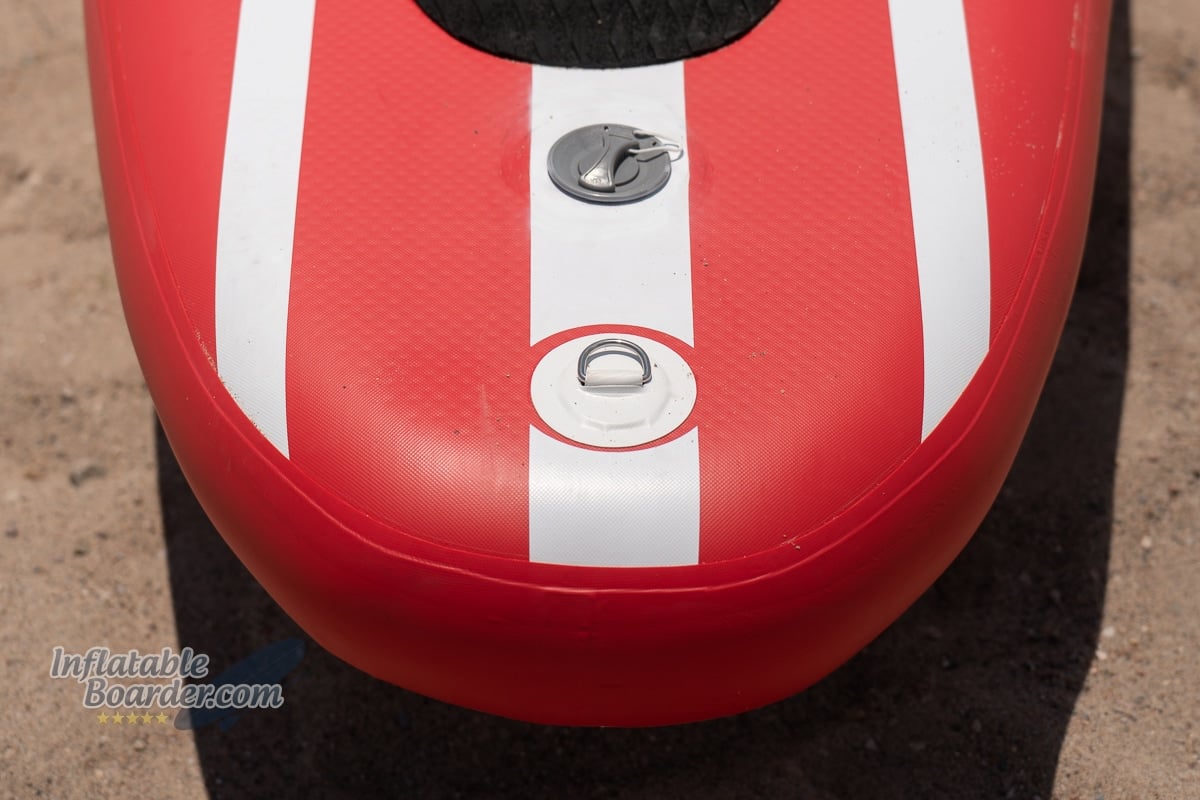
The tail of the board has only the inflation valve and a leash D-ring. The iRace does not come with a leash, you will need to purchase that separately.
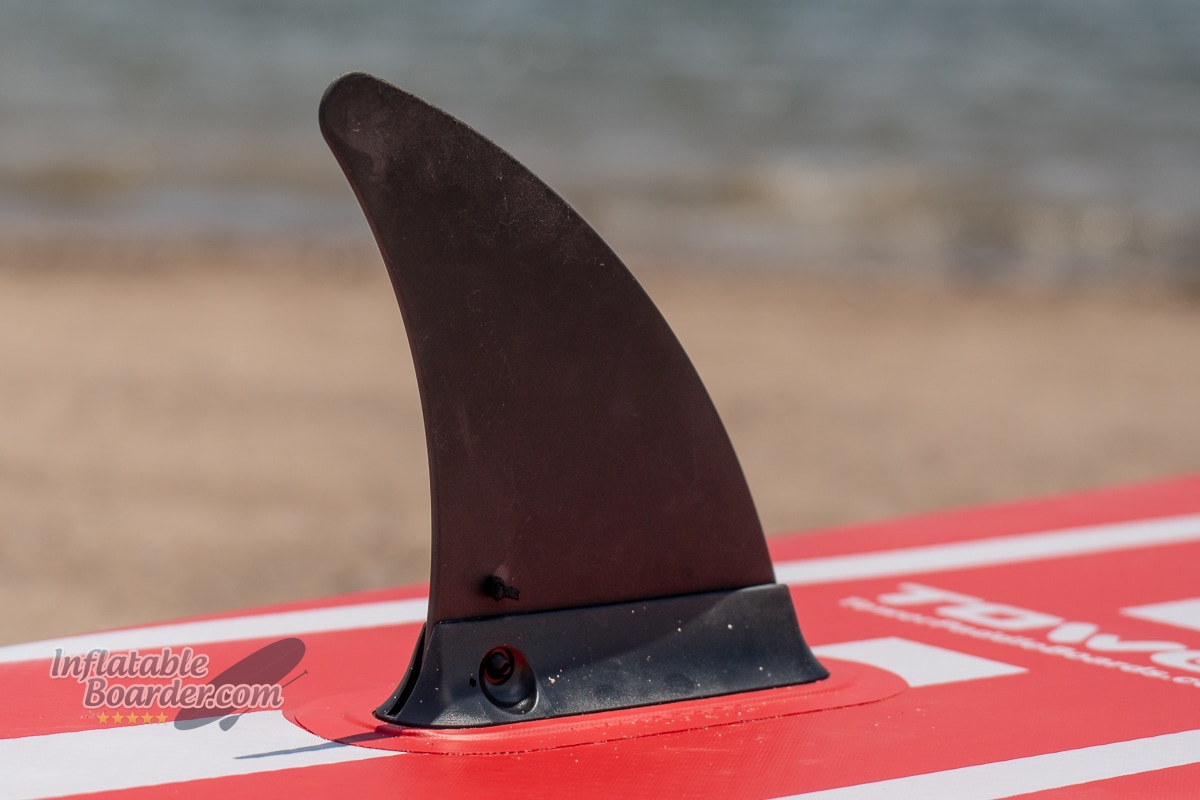
The hull of the board is as straightforward as the deck with only the single hook-and-pin fin box on the tail of the board.
The Tower iRace iSUP comes with the same basic accessory kit as all of Tower’s other iSUPs. Along with the board you’ll get a fiberglass/plastic paddle, 9” fin, small repair kit, and a single-chamber/single-action hand pump with hose and separate pressure gauge. The iRace does not include a storage/transportation bag, nor does it include a safety leash. There is also no cargo storage on the Tower iRace iSUP. The overall shape and size of the board is equivalent to many touring iSUPs, and it performs similarly on the water, but with no way to secure any type of cargo – even a water bottle – its actual usability is extremely limited.
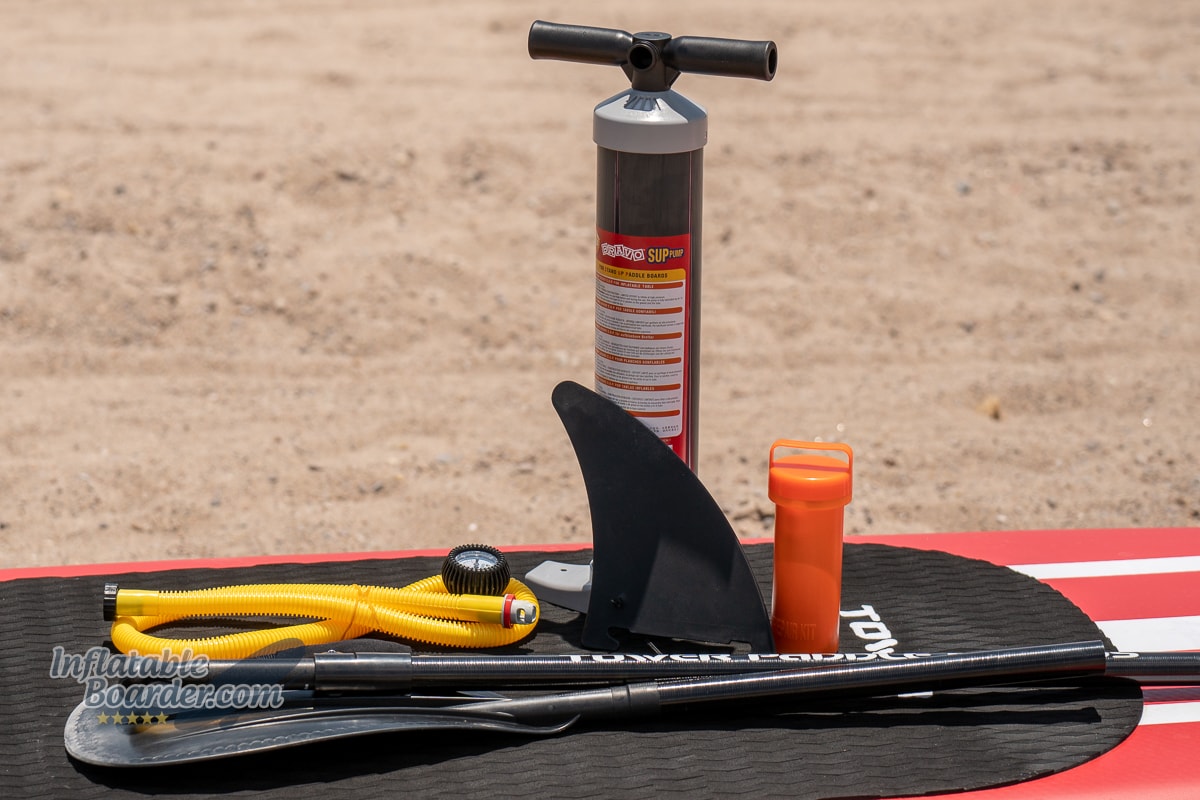
The Tower iRace includes a very basic accessory kit.
Paddle
The Tower fiberglass paddle works well with the Tower all around iSUPs, but is mismatched with the Tower iRace.
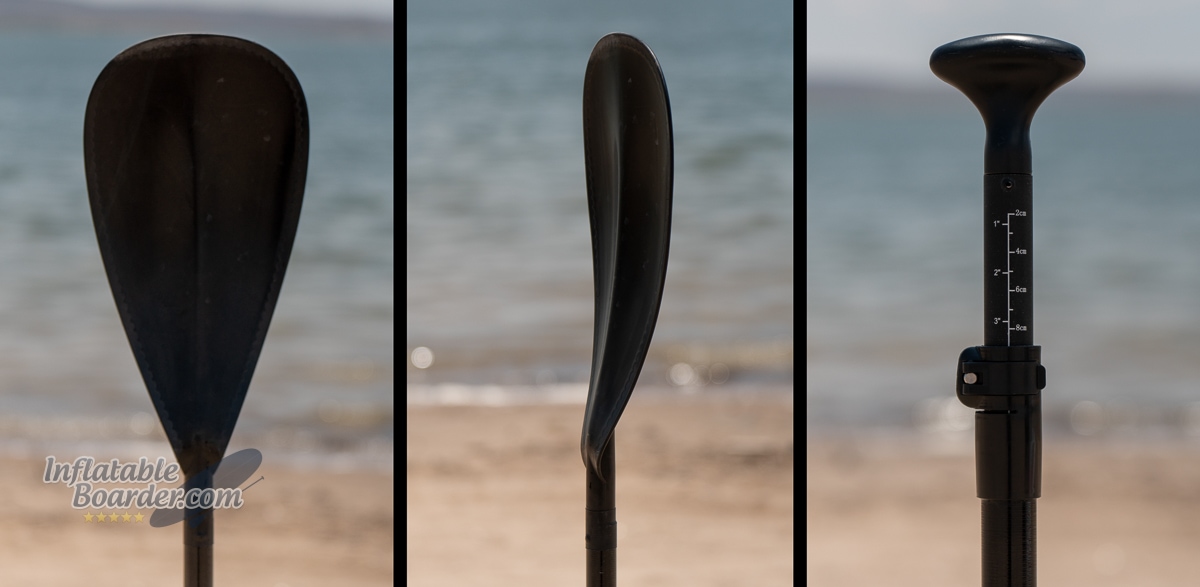
The Tower fiberglass paddle is too large and flexible for faster paddling performance.
The Tower fiberglass paddle is a good companion for an all around iSUP. The large paddle blade is offset by the flexible ABS plastic and fiberglass shaft for comfort during casual paddling. However it’s not a great match for a board that is intended to be paddled with efficiency and speed.
The large, teardrop-shaped blade holds a lot of water with each paddle stroke demanding a slower cadence for optimal performance. Smaller, narrower paddle blades are much better suited to the higher cadence, higher efficiency paddling style for moving quickly on an iSUP. The fiberglass shaft also produces a large amount of flex with each stroke. This flex makes it difficult to translate paddling effort into forward movement as you work to pull your paddle board past the paddle.
Overall the Tower paddle is also very heavy at 34.1 ounces (one of the heaviest non-aluminum paddles I’ve encountered). When paddling for longer distances those weights really add up. The average weight of all of the “kit” paddles we’ve tested (including this paddle and aluminum paddles) is 30.1 ounces. Those extra four ounces mean that in one hour of paddling you will lift an extra 375 lbs of paddle weight at a casual cruising paddling cadence, or 600 lbs of extra paddle weight at a fitness/light racing cadence. With iSUP kits at this price point we typically see more advanced paddle designs with lighter materials and weights well under 30 ounces.
Stability
The Tower iRace iSUP has average feeling stability for a board of its size that doesn’t drastically change while in mildly choppy conditions thanks to its elongated shape.
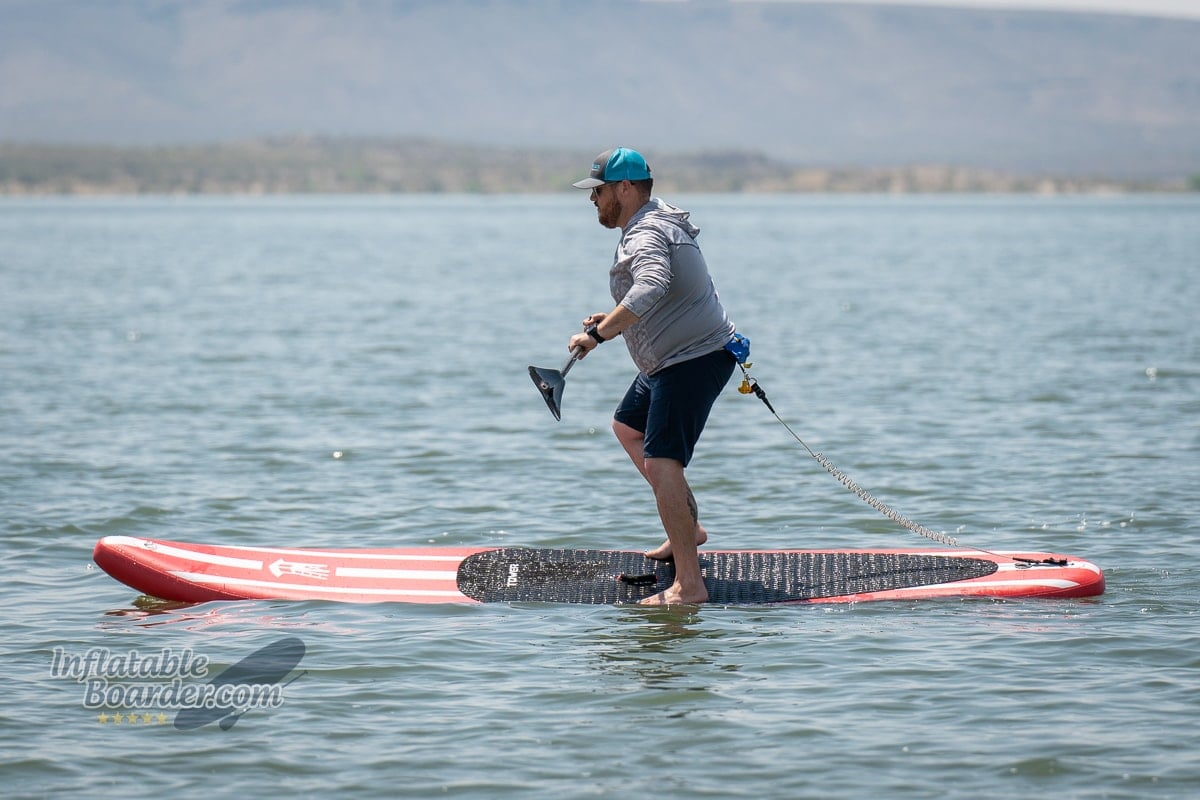
The longer, more parallel outline of the iRace increases its overall stability.
A paddle board’s stability is a combination of many different factors including length, width, shape, and rigidity. Those can be changed around and adjusted in order to achieve differing levels of relative stability. Adding length to a paddleboard or changing its shape can help mitigate some of the loss of stability when making a board narrower. In the case of the Tower iRace, it is two inches narrower than the Tower all-around boards, but two feet longer, giving it more surface area in contact with the water. More importantly, though, the longer size of the board also lengthens the area of it’s maximum width compared to the Tower all-around boards.
While the iRace does not feel as stable initially as the Tower all-around boards (it feels a little twitchier side-to-side), the overall feeling of stability is actually quite close while paddling.
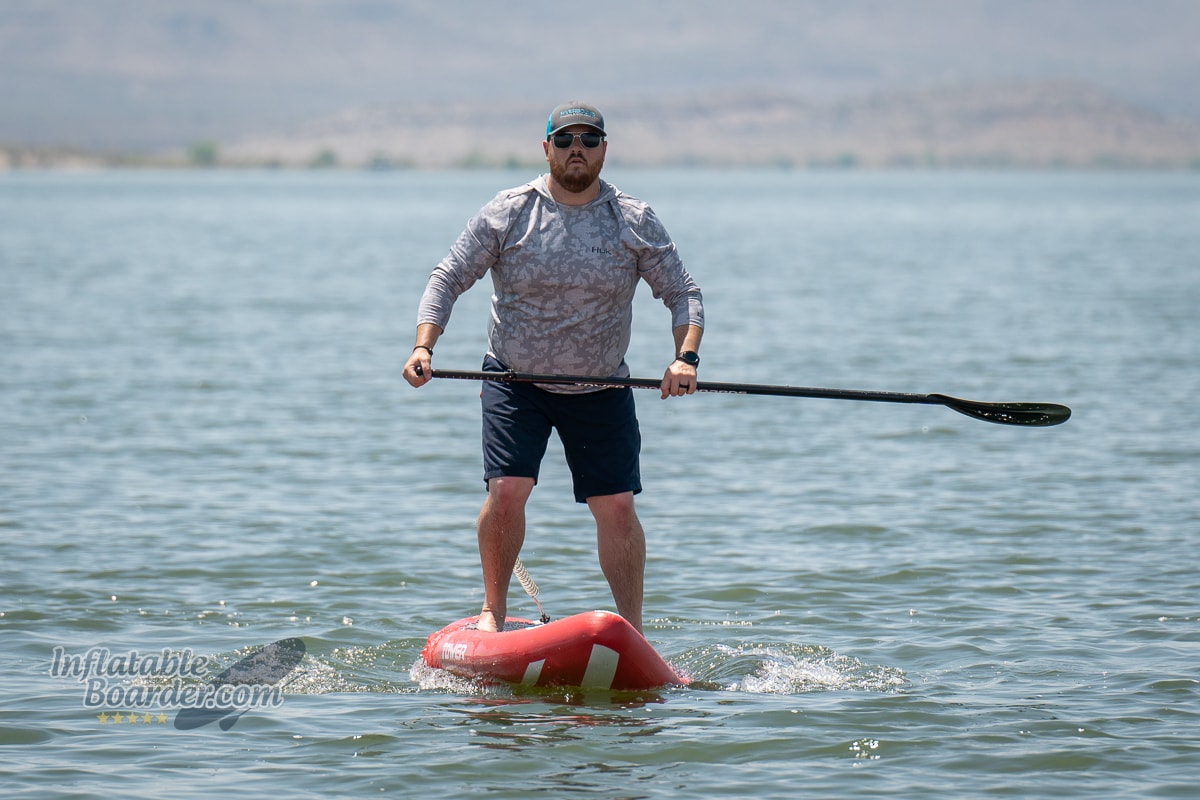
The Tower iRace has decent secondary stability thanks to its more parallel midsection.
The longer midsection of the board also helps increase its secondary stability. This is how stable the board feels when it’s tilted on its side instead of flat on the water. While rocking from side to side or holding the iRace on its edge, the extra surface area in contact with the water really helps to create a more comfortable feeling.
The iRace’s flex can create some issues for stability. I mostly noticed this while moving around on the board and while sprint paddling. As the board flexes it moves up and down independently, requiring you to spend more time and attention on your balance.
Speed
With a longer and narrower shape it’s no surprise that the Tower iRace is the fastest of Tower’s Premium Series iSUPs, but its overall speed is limited by the included paddle and lower recommended pressure.
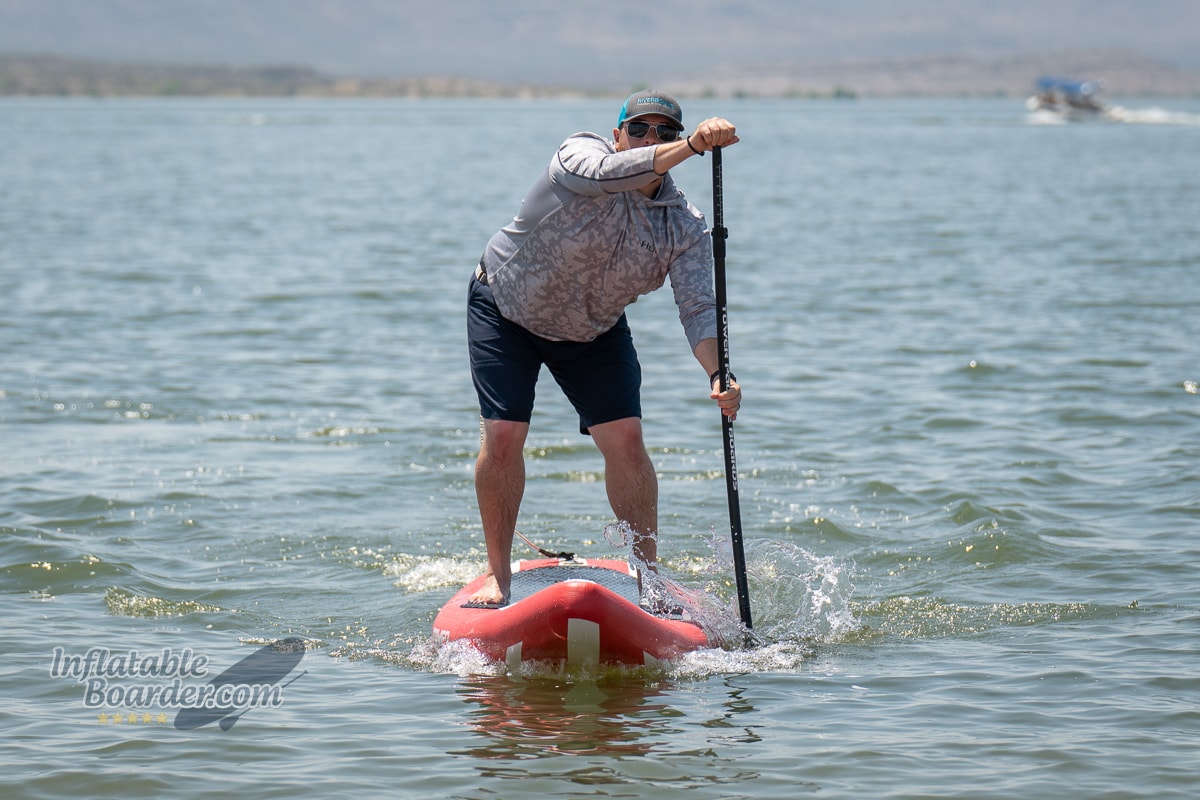
The Tower iRace moves far more quickly through the water than its all-around counterparts.
Going fast on a paddle board is a combination of board design, paddle design, and paddler ability. At 12’6” long and 30” wide, the Tower iRace starts off with a classic touring iSUP sizing. The drawn in nose and tail also point towards a faster design theory. However the iRace’s top speed is held back by its construction and paddle.
In our sprint testing, I could hold the Tower iRace at a consistent 5.6 MPH (9.0 KMH) for short sprints and reached a peak speed of just 5.7 MPH (9.2 KMH). These speeds are in the middle of the range for touring iSUPs. When sprint and peak speeds are this close I’ve found it usually indicates that there is something going on with the board and/or paddle that prevents more effort from producing more speed, even for very short bursts. In this case while sprinting I noticed a significant amount of flex in both the board and paddle. When the paddle board flexes during a sprint more energy is sent pushing the board down into the water instead of moving across it. It also shortens the water line of the board reducing its tracking performance and stability. With a flexible paddle a huge portion of your energy input goes into bending the paddle blade and shaft rather than pulling the board across the water. Lastly, the large paddle blade size and teardrop shape force a heavier pull and slower cadence compared to a smaller, narrower paddle blade. Between the board and paddle flex, the iRace seems to be a bit of a misnomer. It has neither the shape nor size of a racing paddle board, and its ability to perform at higher speeds is lacking.
At more casual cruising speeds the iRace did not have as much flex throughout the board, but still had some. While it didn’t greatly impact the tracking performance or overall cruising speed it is one of those characteristics where you know the equipment could perform better if one or both of those features were improved. At a casual paddling cadence of 25 strokes per minute (essentially paddling comfortably with a quick pause between each stroke), the Tower iRace moved along at a relatively quick 3.7 MPH (6.0 KMH).
We test the efficiency of each paddle board by measuring its glide – or how far it will travel with a single paddle stroke before slowing down. With each stroke the Tower iRace moved an average of 20 feet with each stroke, or 1.6 board lengths. While this is significantly more distance per stroke compared to the Tower all around boards, it’s actually at the low end of things for touring and fitness iSUPs (typically 1.7-2.0 board lengths per stroke). Again, I feel that the board and paddle flex is working against the Tower iRace in this regard.
Maneuverability and Tracking
The Tower iRace was surprisingly maneuverable in our testing given its dimensions, but still maintained good tracking ability as well.
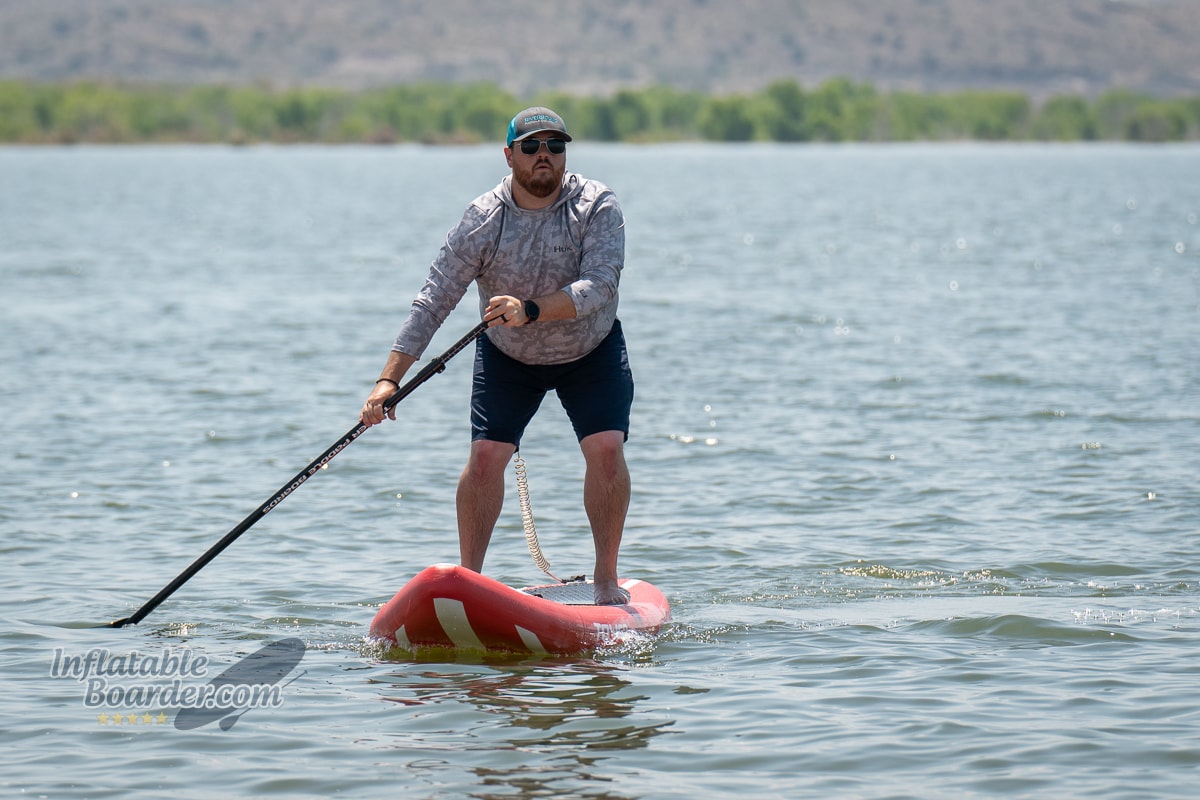
The high nose rocker and tapered shape contribute to the iRace’s easy maneuverability.
While not nearly as swift to turn as Tower’s shorter all-around iSUPs, the iRace did perform well in our maneuverability test for its length. To gauge a paddle board’s overall maneuverability we put it through a stress test – turning a complete 360° circle from a standstill with as few strokes as possible using only the forward sweep stroke (paddling in an arc from nose to tail). The forward sweep isn’t the most efficient turning stroke available to paddlers, but it’s a key stroke used at all skill levels for turning and steering while maintaining forward momentum.
To complete our test, the Tower iRace needed an average of 6 high-quality forward sweep strokes. Tower’s all-around boards all completed the same test with between 4.5-5 strokes, and many other touring-style iSUPs need 7-8 strokes. There are many other ways to turn and steer a paddle board more efficiently like reverse sweep strokes, though they halt your forward momentum, and bow draws, a more advanced stroke that requires careful timing. The iRace responds well with all of these different methods of turning.
It’s also easy to steer the iRace in smaller increments while underway using these same paddling techniques. The high nose rocker, tapered tail, and maneuverability-focused fin all work together to give the iRace this relatively high maneuverability.
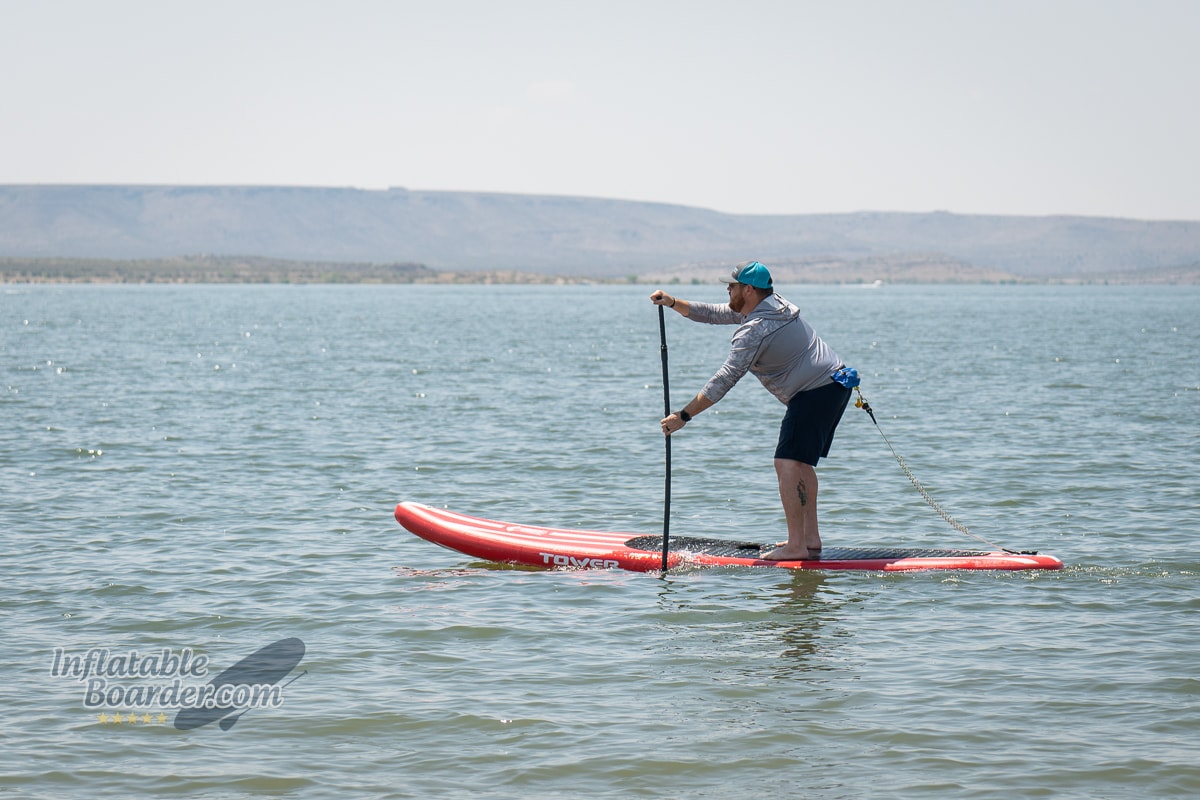
Keeping the iRace on track while cruising is relatively easy, but can become trickier in a sprint.
Similar to our maneuvering stress test, we have designed a stress test for board tracking. While paddling toward a distant target we take 10 high-quality forward strokes in a row on a single side. Then we measure the difference between the original and new courses using a compass. This is more than most paddlers, especially beginner and intermediate paddlers, will be comfortable taking on a single side anyway, but it does give us a good look at how well a paddle board keeps its course.
Over the span of 10 paddle strokes, the Tower iRace deviated from its course an average of 10°. That is far better than Tower’s all around paddle boards and does put it into the range with other touring-style paddleboards. Longer paddle boards with narrower profiles are easier to paddle straight as they have better resistance to turning forces and allow the paddle to stay closer to the centerline of the board during the stroke.
Once you start adding speed into the mix, the iRace’s tracking performance does begin to drop. As you paddle faster and harder there is more body movement and pressure changes on the board which causes it to flex. As you paddle faster and harder the flex increases. As the board flexes the waterline shortens and the board paddles off course significantly faster.

The Tower iRace includes a single 9” all-around style fin.
The Tower iRace takes a small departure in design from Tower’s other iSUPs by having just a single fin box without any fixed side bite fins. This is a great improvement for this board as the small fixed side bite fins found commonly throughout the industry don’t really contribute anything to maneuverability or tracking, but rather just add drag in the water.
Tower uses a hook-and-pin style fin box on all of their iSUPs. This is an easy to use system that requires no additional tools, but there are two major issues I’ve found. First is durability. The pin itself is made of soft plastic and works by pressure-fitting into the hole of the fin box. Even though there is a split in the pin to allow it to squeeze in and out, there’s no way to manually squeeze the pin for either operation. I am worried that this will cause the pin to quickly wear down, and if the fin isn’t seated exactly right, to break the pin. The second issue is that this is an extremely uncommon design and it is very difficult to find any type of replacement option short of ordering a new fin directly from Tower. So if you forget your fin at home or lose it entirely, it’s less likely you’ll be able to borrow from someone or find a replacement locally.
The included fin is 9” long and has a “dolphin” shape more commonly associated with all-around and surfing paddle boards. This shape fin has a wide base for tracking, but quickly loses surface area toward the tip for increased maneuverability. A touring or racing style fin would be a better match for the Tower iRace, however Tower does not make such an option.
Warranty and Customer Support
Tower Paddle Boards warranties the iRace and their other “Premium” line iSUPs for 2 years and offers no explicit warranty on any of their accessories. There is a 30-day return window for new/unused boards (less shipping fees). For all of Tower’s insistence on the quality and longevity of their “Premium” iSUPs on their website it’s a bit disappointing to see only a basic 2 year warranty (and none for the accessories). I would like to see them stand behind their product for longer and offer a 3+ year warranty (their “Elite” series iSUPs use the same construction and receive a 3 year warranty). If you have any questions, you can contact Tower via telephone, email, by appointment at their California retail shop, and through social media.
Overall Impressions/Review Summary
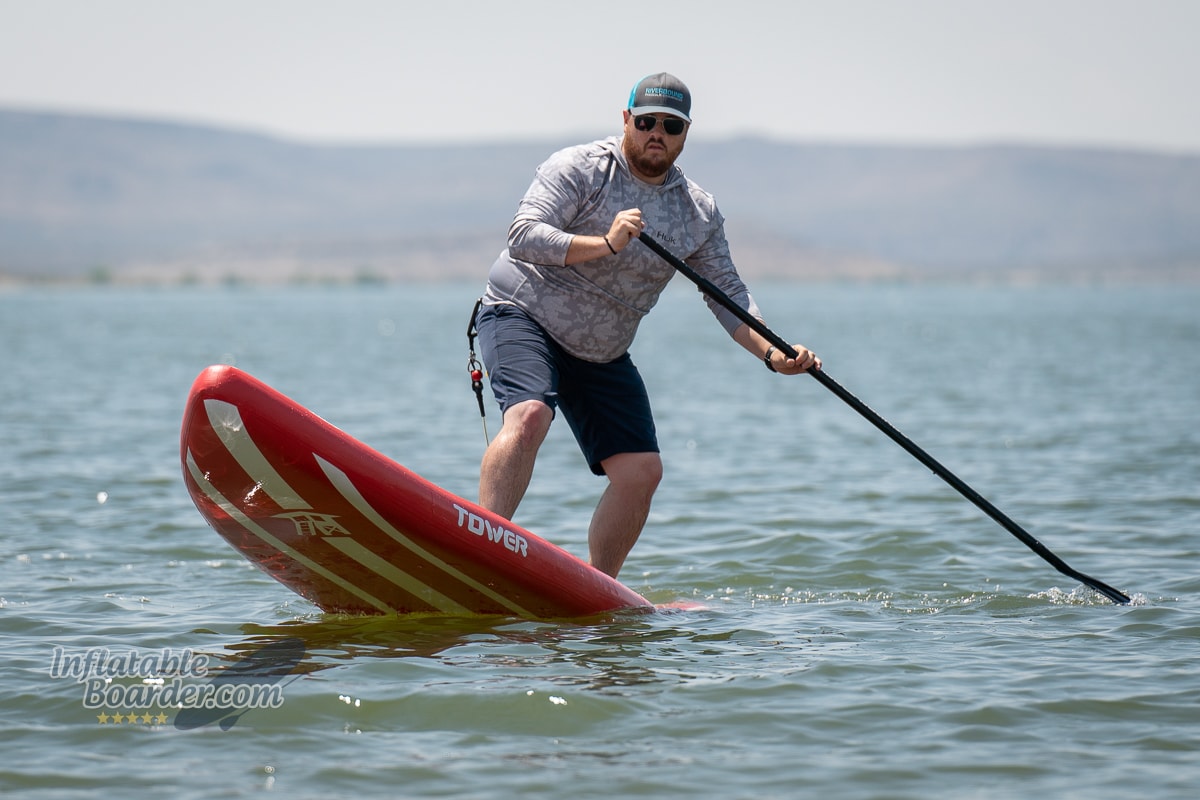
The Tower iRace has potential, but is held back by a self-limiting design.
The Tower iRace is an interesting paddle board. It has the core shape and size of a touring iSUP, and has some good performance characteristics working for it (stability, maneuverability, cruising speed). However it is being held back by some pretty significant issues. The low maximum recommended pressure introduces excess flex into the board, and its inability to carry any cargo at all prevents it from being used for more than an hour at a time (at most). With a few tweaks to the feature set the Tower iRace could be a good option as a touring iSUP, but as it is now, there’s just too much missing from this kit.
Tower iRace iSUP FAQ
Is theTower iRace iSUP good for beginners?
Longer and narrower boards like the Tower iRace are typically not recommended for first-time paddlers as they are harder to balance on and harder to maneuver. However the iRace does have easy maneuverability and decent stability given its width. If you know that you want a slightly faster paddle board and don’t mind a slightly steeper learning curve, but won’t be on it for more than an hour or two at a time, the Tower iRace can be a beginner paddle board.
How long does it take to inflate the Tower iRace iSUP?
With the included single-action hand pump it takes about 8-10 minutes to inflate the iRace to its maximum recommended pressure of 12 PSI, though smaller paddlers may struggle to reach that pressure with the hand pump.
Can I use the Tower iRace iSUP with a kayak seat?
The Tower iRace does not have attachment points compatible with kayak seat conversion kits.
Can I paddle with kids or pets on theTower iRace iSUP?
You can paddle with smaller kids and pets on the iRace, however the 30” width does not provide the best stability for doing so. The deck pad is also fairly small which does not leave much room for comfortable/grippy surface for passengers.





Leave a Reply